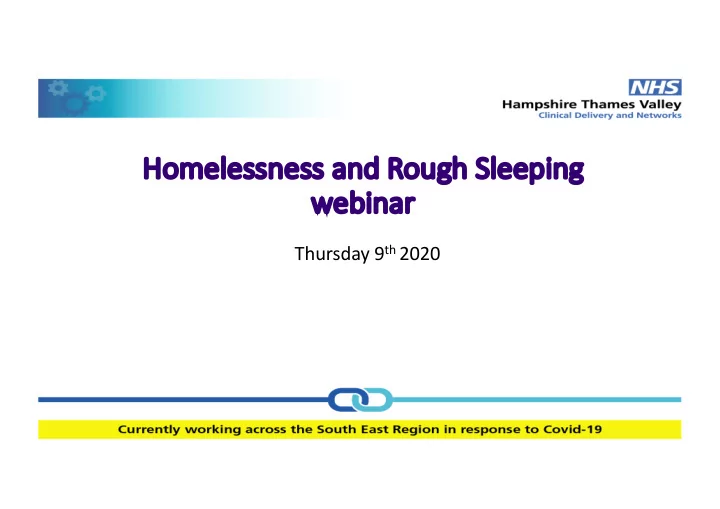

Ho Home melessness and Rough Sleeping we webinar Thursday 9 th 2020
Agenda 11.00 Welcome Olivia Falgyrac-Jones 11.10 Introduction: setting the scene and context Lucy Baker 11.15 Brighton and Hove Case Study Emily Ashmore and Tim Worthley 11.45 Transition Framework Emma Seria-Walker 11.50 Discussion
Ob Objectives for health: • Every homeless person to have a health assessment • Establish how to make every contact count for GP registration and health assessment – what would persuade all the potential contacts of homeless people to signpost to every homeless person • To share information on good practice – avoiding re-inventing wheels • To support people who are supporting multiply-disadvantaged people
Se Setting the scene and context – Mi Ministry of Housing, Communities es an and Local al Govern rnment
Brighton & Hove - Multi-agency approach to COVID-19 and homelessness July 2020
Rough Sleeping in Brighton & Hove – Demand for ‘Everyone’s In’ • Brighton & Hove consistently has high numbers of people rough sleeping in the city. • In March 2020 there were 120 people known to be rough sleeping, an additional 30 people attending day centres who stated they were rough sleeping but had not been found by street outreach, and 52 people in shared sleeping space accommodation • In addition there was a predicted demand of 103 people based on flow of 5 people a week for 12 weeks (half of normal flow) and 40 additional people from dormitory style private accommodation (e.g. backpackers) • Between March 2020 and June 2020 over 400 people were offered accommodation in Care & Protect or other accommodation. 280 of these were verified rough sleepers.
Covid Response – working collaboratively to meet the needs of our population Early Action Enabled Rapid Responses • Early decision by BHCC to accommodate all rough sleepers and move people in shared sleep space accommodation (20 March) • Rapid Acquisition of additional accommodation by BHCC Housing department • Early engagement with health partners and third sector commissioned services including initial work on triaging and cohorting • Early establishment of a Public Health led multi-agency meeting to lead the response
Levers and barriers in rapidly establishing a multi agency response? Levers Barriers Positive and honest pre- Culture and Knowledge existing relationships Gap Shared Values and Accommodation Availability Ambitions and Cost Public Health & Health Lead Finance Political support Staff numbers Clear Guidance New Strategy
What we offered to get ‘Everyone In’ • A Brighton specific protocol for the Treatment and Care of Homeless People • A care hub – self contained en suite rooms, 24 hour staffing, including medical in reach every day from Arch, SCFT Nursing Team, SMS and MHHT, staffing by specialist staff from St Mungo’s • Three Protect Services – 1. MCN/high need clients, 2. ECV and high risk of harm clients, 3. low risk of harm clients • Three meals a day • Personalisation funding and peer befriending
HUB & SPOKE MODEL
Applicability – what might work for you? • Relationships • Leaders • Joint working • Shared Vision • Data
Who are we working with? Assessed Health & Support Needs: % of clients in the Care & Protect Model: Extremely Clinically Vulnerable to Covid-19 with <1% no support needs Extremely Clincially Vulnerable to Covid -19 and 7% Support Needs Significant Underlying Health Needs with no 8% support needs Significant Underlying Health Needs and 18% Support Needs Support Needs (no health needs) 42%
Next Steps – Transition Planning Health Care Hub Infection Control Lead and embedding change Mental Health Homeless Team Primary Care – Arch
Next Steps – Transition Planning Housing, Support and Winter Planning Decant of shortlife properties Move on planning Re-modelling of congregate models Embedding infection control in services Severe Weather Planning
Next Steps – Recovery Planning Future Plans • Increased Housing First • Flipping the Supported Housing Model Dependent on Funding • Dual Diagnosis Rehab Service • Combined Hub – Health, & Support Services • Increased access to housing and support
What went well and what we’d do differently Went Well We’d change this Joint working Include experts by experience Strategic Health and Public Include the VCS in strategic planning Health Lead Redeployment of staff Introduce the Infection Control Lead earlier Health, MH, and Substance Start move on planning earlier Misuse Engagement Trauma Informed Support
Ne Next Steps Transition Frame mework
Feedback/Suggestions for future webinar topics – please answer in chat box • Winter planning – 23 rd July 2020 • More case studies from different areas? • Hot weather planning? • Outbreak/infection control? • Next steps/moving on? • Any other suggestions? Please e-mail: nicholas.hanson-james@nhs.net
Recommend
More recommend